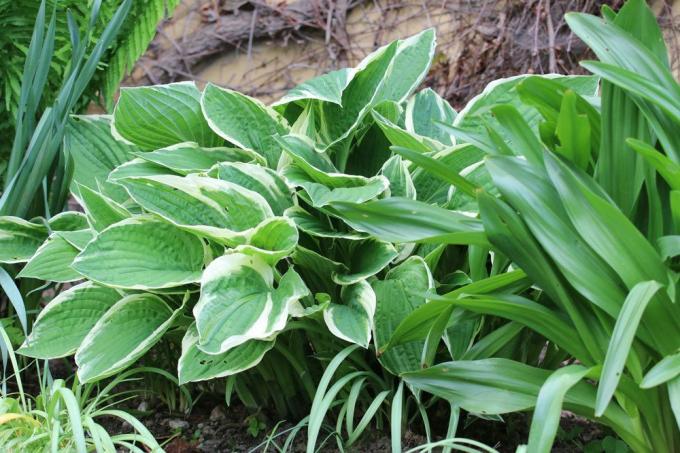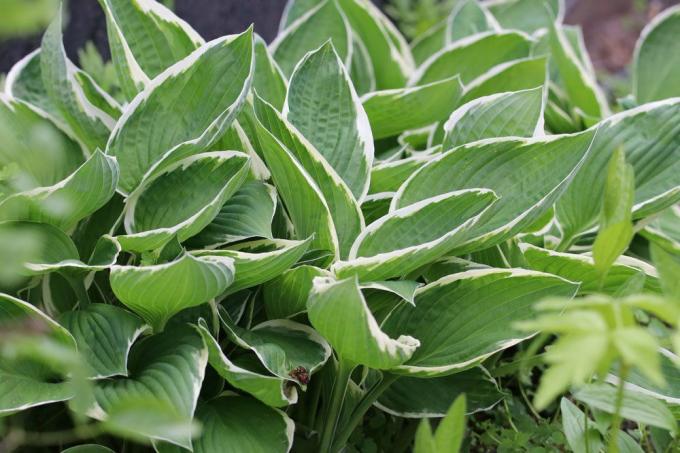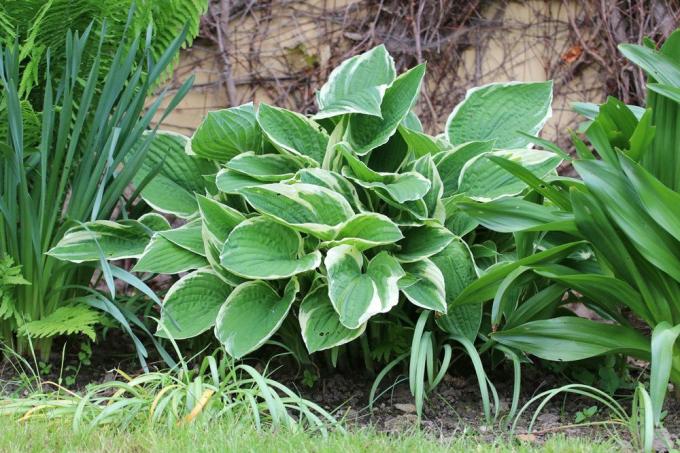
table of contents
- Location
- care
- floor
- plants
- to water
- Fertilize
- Cut
- Multiply
- Pests
- Diseases
Profile and care information open +conclude -
- Flower color
- violet
- Location
- Shadow, penumbra
- Heyday
- June July August
- Growth habit
- upright, spreading, bushy, clump-forming, perennial
- height
- up to 80 centimeters high
- Soil type
- loamy
- Soil moisture
- moderately moist, fresh
- PH value
- weakly alkaline, weakly acidic
- Limescale tolerance
- Calcium tolerant
- humus
- rich in humus
- Poisonous
- Yes
- Plant families
- Asparagus family, Asparagaceae
- Plant species
- Potted plants, Ornamental plants
- Garden style
- Japanese garden, front yard, cottage garden
White-rimmed gray-leaf hostas are a classic among ornamental leaf perennials and have been an integral part of their ornamental beds for many gardeners for years. The gray-green leaves of Hosta x fortunei 'Francee' are striking. A white border adorns the slightly inwardly curved, heart-shaped foliage. The high-contrast plant is equally effective in individual and group planting. As frugal as the perennial, only a few requirements have to be met for successful cultivation.
Location
Avoid locations in full sun
Hosta x fortunei 'Francee' is one of the best known and most popular Hosta varieties. The wild forms and numerous hybrid forms differ considerably in their height and in their flower and leaf color. The beauty of the leaves from distant Asia is hardy and sprouts late in spring. In contrast to the brightly colored foliage, however, the flowers are almost inconspicuous. The white-rimmed gray-leaf funkie has violet-colored flowers that only appear in midsummer.

The asparagus plant is an attractive perennial that can ideally partner with early flowering plants. The empty space of the spring geophythes is enhanced by the striking foliagePerennials filled quickly. The large-leaved perennial feels very comfortable in the partially shaded area. Too much light damages the attractive leaf color. A few hours of sunshine a day, either in the morning or afternoon, are sufficient for the plant. Fully sunny locations can have a negative effect on the leaf color and the hardiness of the perennial.
The heart petals develop their full splendor in bright, sheltered locations. The area of application of the agave family is versatile.
- front yard
- Grave planting
- Japanese garden
- Cottage garden
- Underplanting
- Wooded edge
care
The hostas come into their own when placed in groups. You can also create visual accents with other plants, such as various types of thimble. If you only have a balcony, you don't have to do without the distinctive plants. The ornamental perennials feel comfortable in sufficiently large pots. The maintenance effort increases minimally with potted plants.
floor
Heart lilies are robust and easy to care for, but the perennials with their white-green leaves still make a few demands on the substrate.
- relaxed
- profound
- rich in humus
With regard to the pH of the soil, a weakly acidic to weakly alkaline value is preferred. Hardly any plant can grow in a heavy, compacted substrate. Hosta x fortunei 'Francee' is no exception. It is worth preparing the soil sufficiently before planting. Drought and root pressure can quickly cause the substrate to compact.

This can be effectively counteracted with two methods: expanded clay pellets and regular mulching. The expanded clay loosens the soil permanently and stores small amounts of water. Mulching between closely spaced hostas is difficult. Neither the leaves nor the roots of the perennials should be damaged by this measure.
The white-rimmed gray-leaf Funkia in planters is satisfied with conventional potting soil. Small amounts of lime do not harm the plants and do not inhibit the absorption of water and nutrients.
plants
The asparagus family does not belong to the kind of perennial that enriches the background inconspicuously. The green leaves with their white border immediately catch the eye.
- Allow the root ball an extensive water bath before inserting it into the substrate
- the dug planting hole must be twice as wide as the roots
- Loosen the surrounding soil with a digging fork
- Spread a layer of compost in the planting hole
- Mix the excavated earth with humus and small amounts of clay
- Insert the Funkie and fill the cavity with prepared substrate
In the first few weeks, the plant is insufficiently able to absorb nutrients and water from the soil. Fertilization plays a subordinate role in this phase. It is more important to keep the soil sufficiently moist for about 2 to 3 weeks. There is no rule of thumb for planting in ornamental beds. The growing season is ideal so that the perennials can adequately prepare for winter.
A group planting of Hosta x fortunei 'Francee' creates a special picture. Here it is advisable to put a maximum of 3 hostas on one square meter. In this way, the individual plants cannot hinder their growth and compete for water and fertilizer.

Cultivation in the bucket
You don't necessarily have to have a large garden to enjoy the decorative leaf ornamental shrubs. A shady spot on the balcony is enough for the asparagus plants. The advantage: If the plants do not like the selected location, the container and the plants can easily be moved to another location.
The flower pot should be big enough so that the ornamental plant with the large leaves can develop undisturbed. Instead of an expensive clay vessel, mortar tubs from the hardware store have also proven themselves. The urgently needed drainage holes can be created quickly with the help of a cordless drill.
The most important element in the bucket is the drainage on the bottom. Usually this consists of porous, non-rotting material. This system allows irrigation and rainwater to drain off quickly, thus preventing dangerous waterlogging.
- the roots of the plant must not touch the drainage layer
- an approx. 10 cm high substrate layer
- Regularly remove excess water from the saucer and planter
The planting time differs slightly from the cultivation in the ornamental bed. Funkia in the bucket are more sensitive to cold than their relatives in the garden. In order to give the perennials sufficient time to acclimatize, the plants should be placed in containers by the end of August at the latest. The topic of "repotting" plays a subordinate role. The plants can grow undisturbed for 4 to 5 years in a large pot. Only when the roots visibly fill the entire bucket is a move to a larger container imminent. Or you can use this opportunity to rejuvenate the agave plants by dividing the roots.
to water
The shade-tolerant plant does not make any exotic demands on the watering behavior.
- Avoid waterlogging
- prevent the root ball from drying out
- calcareous water is tolerated
- do not pour over the leaves
Irrigation and rainwater can quickly seep away in loose soil. This has the advantage that the roots of the agave family are not exposed to standing moisture and thus provide the ideal foodstuff for tubular mushrooms. To prevent the valuable moisture from evaporating too quickly on hot summer days, a layer of withered leaves or Plant sections are applied around the hosta.
White-rimmed gray-leaf hostas in the bucket run the risk of drying out quickly. The absorption capacity of the substrate is limited. Check the plants regularly and water immediately as soon as the top layer of soil is completely dry. Pale and droopy signs can indicate a lack of water. The plants recover, but this care mistake makes the petal lilies susceptible to diseases and Pests.

Fertilize
The decomposition of organic matter slows down in shady locations. The nutrients from leaves and dead plant residues enrich the soil with nutrients over a longer period of time. An ideal basis for the large-leaved ornamental perennials. Hosta x fortunei 'Francee' is not one of the heavily draining plants.
- in spring or late summer compost or Spreading horn shavings
- Maintain potted plants with slow release or liquid fertilizers
- Halve the quantity of products purchased
- is fertilized from April to August
You should completely avoid bark mulch when caring for and cultivating heart leaf lilies. The material must not be used as a fertilizer or to protect against cold and drought. None of the numerous hosta species can tolerate the pieces of bark.
An overdose of nutrients is quickly noticeable in the ornamental leaf shrubs. The foliage changes color and takes on a white to yellowish hue. The plants cope better with a poor substrate than in an over-fertilized soil. It is helpful to take effective countermeasures in an emergency. Replacing the top substrate layer only helps with young and freshly planted perennials. For approx. 6 weeks on the supply of fertilizer.
Cut
Just in time for the beginning of autumn, the starting shot has been fired for many hobby gardeners to make their home garden landscape winter-proof. In addition to spreading bark mulch, this measure also includes removing wilting leaves. The following applies: Stay away from Hosta x fortunei 'Francee'! The withering leaves of the perennial act as natural frost protection and keep the cold and frost away from the roots. The soft foliage rots quickly, the little remains can be easily removed.
If you still can't keep your fingers still, you should spread a thick layer of brushwood over the plantain. A topiary is not necessary for the herbaceous, deciduous plants. Individual dead or disturbing shoots, such as withered flower stems, can be removed at any time.
Overwinter
Agave plants in the bucket can be brought safely through the cold season as follows.
- Wrap the vessel with a thick blanket or burlap
- keep the bucket near the house
- moving to winter quarters is unnecessary
- do not water or fertilize
The frost protection of potted plants can be removed in early April. The white-rimmed gray-leaf funkie can withstand temperatures of down to -25 ° C without any problems.
Multiply
Hostas are robust and frugal. This is also noticeable when they multiply. Compared to other plants, which reproduce either by shoots or seeds, the agave plant remains a single specimen. If you want to raise offspring of the Hosta, you have to resort to another method. The successful way to propagate hostas is by root division. You can do this before the onset of the first frost in autumn.
- choose an older, healthy plant
- Cut the gnarled root ball into equal pieces
- a spade or a sharp ax are suitable for this task
- insert the root pieces in a humus-rich substrate
- pour vigorously

The Hosta x fortunei 'Francee', which grows up to 80 cm high, needs 4 to 5 years before it shines in its full splendor. Provided that the perennial is not rejuvenated by root division during this time.
Pests
The shade-loving hostas add color to the garden, but it is not only people who enjoy the plants. Snails have no eye for the playful beauty of Hosta x fortunei 'Francee'. The slimy pests enjoy the nutritious leaves of the plants much more. It is difficult to keep the voracious reptiles away from the ornamental plants.
- Copper in the form of pipes or plates only has a limited effect
- nudibranchs avoid a layer of sand
- if the population is high, collect the animals at night
- Exposing predators such as tiger snails or ducks
Setting up beer traps is counterproductive and can quickly turn into the opposite. Thanks to the snails' fine sense of smell, it is not just their own pests that gather around the strongly smelling liquid. The neighborhood should look forward to snail-free gardens soon. One way to get the infestation under control is to sprinkle slug pellets. This product, which contains a lot of chemicals, must be kept out of the reach of children and pets.
Aphids are another variety of pests that do not stop at the white-rimmed gray-leaf hostas. If the plants are weakened by the location or improper care, the cell sap is sucking insects easy game. The small lice prefer to settle on the underside of the leaves and the shoot axes. It's not uncommon to first notice the sticky surface that the honeydew leaves on the animals. The excessive occurrence of ants on the plants is also a sure sign of aphids. Infestation with the small pests rarely leads to the death of the plant. Even so, it makes sense to take effective countermeasures.
- Pour and spray with a diluted nettle stock
- Wipe severely infected shoots with a cloth and soapy water
- Spread ladybirds and lacewing larvae nearby
- Set up glue traps
There are numerous tips and tricks on how to get rid of aphids and many other insects that feast on the cell sap of the hostas. All of these measures have one thing in common: time and patience are required. In contrast to insecticides from specialist retailers, natural home remedies work slowly. On the other hand, they are sustainable and only have a minor impact on the surrounding flora and fauna.

Diseases
In addition to root rot, which is caused by incorrect watering and a lack of drainage in the substrate, the Hosta virus X (HVX) is a pathogen that has to be taken seriously.
Waterlogging
A strong smell and clearly caring perennials are an indication of root rot. The disease caused by fungal infections cannot be combated, but it can be avoided. In the event of an infestation, the plants can be converted into dry substrate immediately. In many cases the plants will recover.
HVX
The virus infection has been known since the 1980s. The plant-specific Potex virus changes the drawing of the leaves and can have a negative effect on the growth of the perennials. A stunted growth and sunken tissue is not uncommon. Infection rarely leads to the death of the host, but the plant is a potential danger to other ornamental perennials. The viruses are spread through the sap of the plant. Hygiene is imperative when caring for Asian plants. This includes wearing gloves and thoroughly cleaning the equipment used.
There are no chances of a cure for infested perennials. The heart petals should be removed from the bed immediately and disposed of with household waste.



